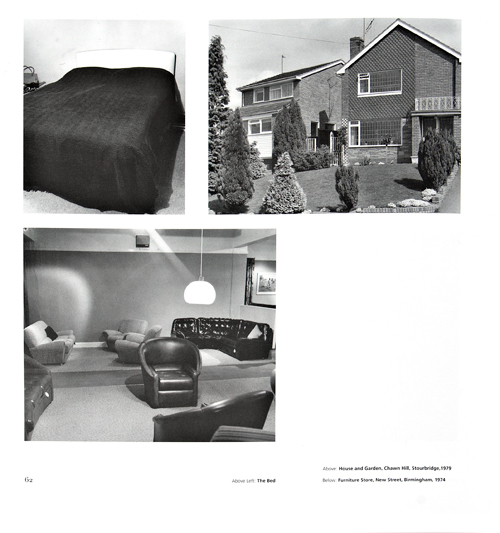| SIMON DENISON IMAGE & TEXT |
| PREVIOUS | NEXT |
JOHN MYERS: MIDDLE ENGLAND Icon Gallery, Birmingham
John Myers, an English artist now in his late 60s, made several series of photographs during the 1970s in his home town of Stourbridge while on the staff at Stourbridge College of Art. His photographs made a modest impact at the time: they were included in one or two group shows and magazines, and Myers received an Arts Council grant to self-publish a book of portraits in 1974. Since then, it is surely fair to say his name has fallen well below the national photographic radar. Trained previously as a fine artist, he later returned to painting. The revival of interest in Myers through the Icon Gallery’s current retrospective is justice well served; not only because of the plentiful riches to be found in the photographs, as artworks and documents, but also because we can now see what an unacknowledged pioneer he was in so many photographic fields. His elegant formal representations of mundane features of the urban environment owe a little to Atget, and parallel to some degree work made in the States (Adams, Gohlke, Baltz), but more closely prefigure the German School and the work of later British photographers such as John Riddy. He was a typologist (television sets, electricity substations) before the Bechers made the term their own. His environmental portraits of ordinary Stourbridge residents owe something to Sander and Arbus but in their static, deadpan qualities also look forward to much work made in the 1990s and beyond (Dijkstra, Hunter, Struth). The work on show is enormously varied, not only in genre but in photographic style and in the meanings the work seems to suggest. This is not a fault. The art establishment may expect artists to be consistent, as it makes them easier to categorise and review. Yet as humans we are inconsistent, adopting different subjective positions from moment to moment. We can see this flickering of contradictory impulses across Myers’s work. What unites it is his insistence on making photographs out of everyday subjects, found within walking distance of his home. Beyond that, he adopts no single conceptual position. Take for instance his pictures of ‘new estate’ houses. Manifestly composed (in most cases) as edge-to-edge, clean arrangements of pattern and tone, with architectural masses and details, pathways, lamp-posts, telegraph poles and wires co-opted as structuring devices, they have the formal qualities that Robert Adams claimed as the essence of photographic beauty. Such clean arrangements are not found everywhere, they have to be sought and selected. They cannot represent, pace Eugénie Shinkle’s catalogue essay, ‘sardonic commentary on the new suburbs … subtle mockery of the urban planner’s (lack of) vision’, as they contain no signifiers of condemnation. If anything, by making us look at these houses, closely perhaps for the first time, they force us to recognise the effort that has gone into their design. Thinking, then, that Myers is out to delight us, we are brought up short by claustrophobic images such as The Bed. Almost filling the frame, the amorphous double-bed of the title is covered top to toe, pillows included, in a monochrome dark bedspread. To one side of the bed is an unfocused handbag on top of some unrecognisable clutter; on the other, an indecipherable shape (perhaps a magazine) in the shadows on the carpet (two occupants, then). The eye remains trapped in the shapeless dark form. The picture raises the idea of rest, comfort, sex; but allows no way in, no way out. The tensions in the image are almost painful. Myers has spoken of his desire to ‘document’ his environment but the meanings of The Bed, as of the suburban houses, are almost entirely contingent on photographic strategy. Yet all photographs can, of course, be read for factual information and for those of us who lived through the 1970s these pictures – especially the portraits and interiors – are a nostalgic feast. Ah, those eye-popping carpets, those cowboy boots and crazy knitwear combinations, those potted plants, that Donny Osmond poster! For all the flamboyance of the period’s style, it is easy to forget just how much poorer, or less acquisitive, most people were then. To judge by the books (art) and records (classical) on display, these are mostly educated people’s homes, art-college lecturers’ and their friends’ homes presumably, but they have almost nothing in them. We are looking here at the English lower middle class interior before Changing Rooms and Ikea, before we became a nation obsessed with ‘styling’ and home improvement. Granada television sets, wires trailing on spindly stands, had not yet become the giant fetishes we venerate today. Myers claims that the people and places he photographed were ordinary, neither particularly attractive nor particularly strange, but to read these pictures of a contained 1970s world today is to be struck above all by their pastness, which is a distinct form of strangeness and one tinged with melancholy. Take the three early images of a Birmingham furniture showroom, made in an unfinessed snapshot style. We seem to be looking at workaday records of a place, a set of arrangements made nearly forty years ago and freighted with intentions, with hope. Three-piece suites of that period have fallen decisively out of favour today. It is not uncommon to find them now, dumped in urban back-lots or woods, their cheap foam fillings spilling out into the weeds. Yet here we see them, in images as still and silent as the rest of Myers’s oeuvre, factory-fresh, expectant, at the moment of their greatest appeal, the moment when they might become your household’s biggest single purchase after your car, an exciting if nerve-wracking moment when their life (and yours with them) is about to begin. |
 |
|---|---|